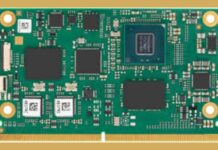MALVERN, Pa.— Vishay Intertechnology has announced upgraded TSOP2xxx, TSOP4xxx, TSOP57xxx, TSOP6xxx, and TSOP77xxx series infrared (IR) receiver modules for IR remote control applications with a new Cyllene 2 IC. Designed in-house to ensure long term product availability and reduced lead times, the new IC allows designers to achieve higher performance with drastically reduced current consumption over a wider voltage supply while offering improved robustness against ESD and direct sunlight.
The enhanced Vishay Semiconductors receivers released are designed for IR remote control in consumer televisions, set-top boxes (STBs), audio and gaming systems, air conditioners, and other appliances, in addition to industrial automation controls, lighting systems, and more. For these products, the devices provide immunity against disturbances such as IR emissions from CFL lamps and RF emissions from on-board Wi-Fi antennas.
Offering designers plug and play replacements for the original receiver modules, the enhanced devices offer 50 % lower current consumption down to 0.35 mA typical over a voltage supply range from 2.0 V to 5.5 V — increasing battery life in mobile consumer electronics, such as robotic vacuum cleaners. For increased reliability, the devices provide higher ESD withstand capabilities to 12 kV (human-body model), while their robustness under direct sunlight results in improved performance for outdoor applications like garage door light barriers.
To simplify designs, the receivers feature a photodetector, preamplifier circuit, and IR filter in a single epoxy Mold (TSOP2xxx and TSOP4xxx), Belobog (TSOP57xxx), Panhead (TSOP6xxx), or Heimdall (TSOP77xxx) package. The devices are available with carrier frequencies from 30 kHz to 56 kHz and different automatic gain control (AGC) versions for long or short burst codes. RoHS-compliant, halogen-free, and Vishay Green, the receivers offer excellent immunity to ripple noise.
Samples and production quantities of the upgraded IR receiver modules are available now, with lead times of eight weeks.

















